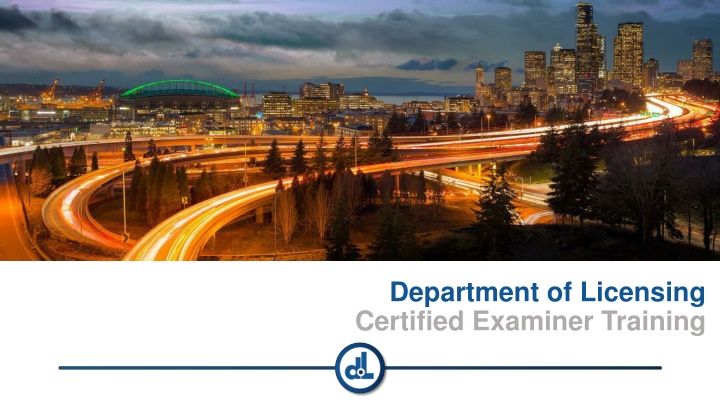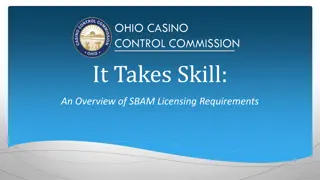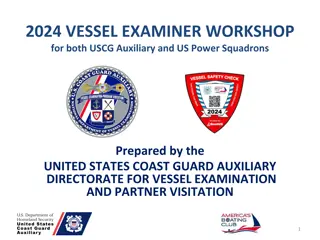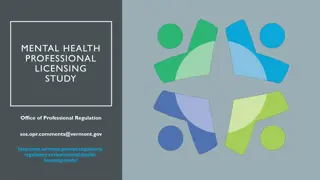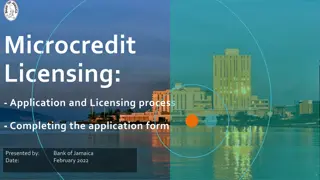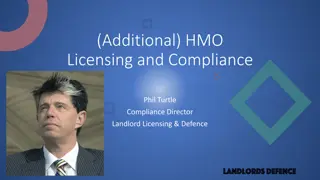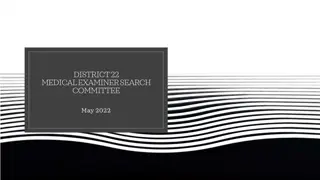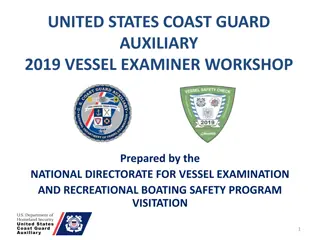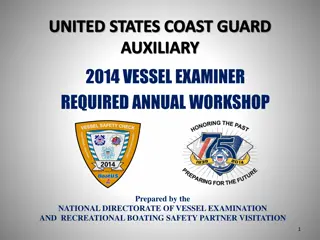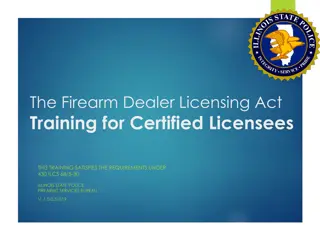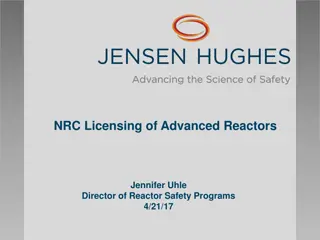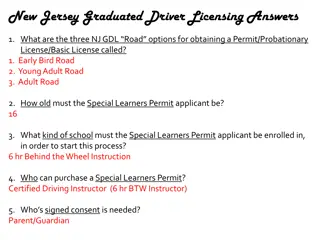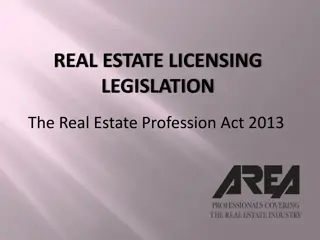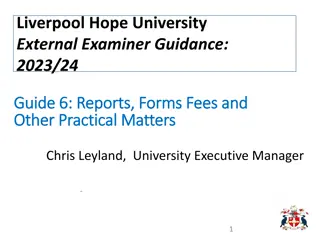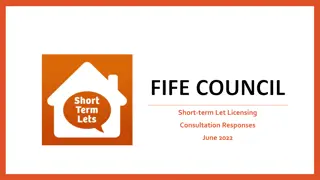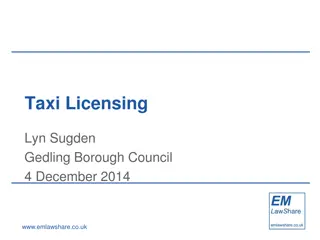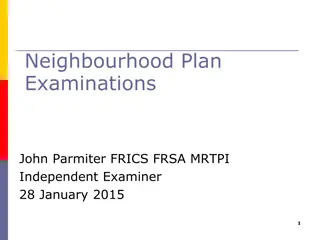Department of Licensing Certified Examiner Training Overview
Department of Licensing Certified Examiner Training provides knowledge and skills for conducting drive tests, focusing on guidelines and requirements. Certified Examiners play a crucial role in ensuring public safety, school approval for tests, reliability, validity, and community well-being. The training includes DOL-approved 18-hour sessions taught by Master Examiners, with rigorous testing standards. Participants must complete online tutorials and pass quizzes before engaging in classroom components. Various resources and exercises are offered to enhance learning.
Download Presentation

Please find below an Image/Link to download the presentation.
The content on the website is provided AS IS for your information and personal use only. It may not be sold, licensed, or shared on other websites without obtaining consent from the author.If you encounter any issues during the download, it is possible that the publisher has removed the file from their server.
You are allowed to download the files provided on this website for personal or commercial use, subject to the condition that they are used lawfully. All files are the property of their respective owners.
The content on the website is provided AS IS for your information and personal use only. It may not be sold, licensed, or shared on other websites without obtaining consent from the author.
E N D
Presentation Transcript
Department of Licensing Certified Examiner Training
Certified Examiner Training Module 1 Introduction & Training Purpose/Steps
Purpose This course provides participants with knowledge and skills to conduct drive tests. This course is designed to help participants prepare for drive test certification. This course will focus on material covered in the Instructor Examiners Guidelines and Requirements 2021.
Why we need Certified Examiners: For the public: Applicants can quickly and conveniently receive a knowledge/drive exam For our schools: Approval from DOL to administer DOL required tests For reliability: Gain the skills and knowledge to reliably administer a knowledge/skills test For validity: Assure eligibility for licensing from all applicants For our community Ensure that drivers demonstrate knowledge and skills to safely operate a motor vehicle For our future Contribute to our state s Target Zero goals
Certified Examiner Training Includes: DOL-approved 18-hour training, taught by a DOL-endorsed Master Examiner (ME) The training certifies Instructors to administer the Knowledge & Skills Tests The 18-hour training should meet the same standard of training as is required by DOL for its own employees & should be delivered as DOL prescribes Following completion of the training, Certified Examiners (CE s) must show the ability to properly administer the Knowledge & Skills Tests and meet DOL testing standards
Training Hours (Homework) Prior to the Classroom Component (4-hrs.): Complete the DOL Examiner Training Tutorials online Pass the tutorial quizzes with scores of 100% Read the current Instructor Examiners Guidelines & Requirements Manual (IEGR) 2021
New Pre-CE Course Tips Offered in Tutorials Verbiage Flash Cards Map Footprint Exercise
Understanding the Footprint of the Score Sheet MANEUVERS- You will NEVER reference these until the maneuver. Don t get lost looking for an error in this part of the score sheet unless a maneuver is being performed Majority of traveling errors will occur in these area Majority of traveling errors will occur in these area
Training Hours (Classroom) Classroom Components include (6 hrs): Introduction, overview, and read the CE Training Expectations letter to the students Sign an attendance roster each day Instructor reads the welcome and purpose of training letter titled Certified Examiner Training Expectations Provide training following the DOL Examiner Training Power Point, using a projector screen that all in the class can see, and each student be provided an Instructor Examiners Guidelines and Requirements manual with associated training materials in hard copy form Complete and review in class, the scoring worksheet
Training Hours (In-vehicle) In-vehicle Practice & Observation (8-hrs,), each drive consists of: In-vehicle examiners practice Vehicle Inspection & applicant checks (brake reactions, etc) In-vehicle practice scoring drives a minimum of 4 Verbiage Observations Minimum of eight (8) skills test observations Final Practice Drive (if needed) Used as an overall assessment for trainees who appear to need additional training
In-Vehicle: Practice scoring drives (4 Minimum) Trainee must complete a minimum of four (4) practice scoring drives as the examiner Master Examiner drives, acting as the mock applicant for trainees Trainee acts as Examiner scoring from the front seat Trainee gives Master Examiner practice drive results after the drive is over Post-drive feedback (while in vehicle) is provided after each mock drive test. This includes, answering scoring questions after each maneuver is permitted. By the last drive, the candidates should be able to complete the scoring without assistance May use training tools such as the verbiage script sheet or scoring job aid (See Appendix 9 Drive Test Scoring Job Aid in IEGR).
In-Vehicle: Observations (8 minimum) Trainee must complete a minimum of eight (8) skill test observations (scoring from the back seat) Trainee observes practice scoring drives from back seat while filling out a score sheet If there are not enough trainees, you can use additional practice scoring drives as a substitute for the required observations Trainee gives post drive feedback about the observation to the Master Examiner
Training Guidelines Specific Training Guidelines Complete training within 3 days Training has to be given in subsequent or adjacent days No late enrollees or partial credit Must complete all components of training in set time Send DOL DTS Program all training documentation
Post Training Check-ride The check-ride must occur no sooner than 7 days, and no later than 45 days, after completion of the Certified Examiner training course The Certification Check-ride is conducted by the certifying Examiner and administered to a DOL-endorsed ME (as a mock customer) for the purposes of demonstrating the ability to properly administer a Skills Test
Check-ride Requirements Reasons for Disqualifying a Check-ride If the Master Examiner scored the drive as a failing score while the certifying examiner scored the drive as a passing score Does not perform equipment check, brake reaction test, or hand signals Failure to perform one or more of the maneuvers, complete the route, or fails to complete the entire maneuver Coaching, bribery, and inappropriate behavior Poor awareness Not using verbiage verbatim Scoring Errors: Failure to add the total score correctly Failure to score 3 or more Danger Potential deductions Missing 30% or more of the total deductions (under scoring) Not recording deductions (mental scoring) Lack of knowledge on where to put the errors Not scoring repeat errors (using hash marks) Over-grading (scoring errors that are not errors)
Check-ride Requirements Guidelines If an instructor fails three certification check-rides, then they do not qualify for certification as a Certified Examiner If an instructor fails to qualify for certification, they will not be permitted to administer any skills examinations for six months from the date they failed their third certification check- ride An instructor that fails to qualify for certification may elect to become a Certified Knowledge Examiner during the six-month waiting period After six months, instructors may make another attempt to become a Certified Examiner, if they: Meet the qualifications to become a Certified Examiner Re-take the 18-hour Certified Examiner training Successfully pass a Certification Check-ride without the use of job aids
Processing a Check-ride The certifying Examiner must exhibit all the primary requirements listed on the Certification Checklist, in order to be certified. Following the Certification Check-ride, the Master Examiner (ME) must complete the Examiner Assessment Report (EAR) & send it to DOL for review and status processing.
Drive Test Check-in Check applicants DOL number through License Express (If they don t have one, send them online to pre-apply @ https://secure.dol.wa.gov/home/newDriver.aspx) Check if they are flagged to test at LSO, if this is the case refer them to nearest LSO office Check valid knowledge test PASS score within the last 2 years Check route (always using next alternating routes) Check valid course completion if under 18 years old Check name/birth date is correct in License Express (refer the applicant to call LSO customer service if this is incorrect)
Identification Something that associates the person taking the exam to a name, date of birth, or identifying photo and/or signature. Note: Only original or certified copies of authentic documents from issuing authorities are accepted for evidence of identification. Typical documents include (expired less than 6 years and you can still identify the applicant): WADL, WAID, WAIP (with photo) Out of state DL, ID, or IP (list the state) US or foreign passport (list the country) Other US government issued documents: Tribal ID with photo, residency card, police identification Alternate documentation: School ASB card with photo with a date of birth document (birth certificate or non-photo WAIP) Foreign ID Cards (check google images in verification if unsure) School yearbook photo with a date of birth document (birth certificate or non-photo WAIP) Check IEGR 3.2 Eligibility for examinations NOT ACCEPTABLE: Costco cards, photocopies, personal mail, international drivers licenses, etc
Insurance Includes: Name of the policy holder, description of the vehicle, effective date of coverage and expiration date and policy number. (List both effective & expiration) SR22 or Broadform are acceptable Insurance may be presented in an electronic form Rental cars are only acceptable if the person is a licensed driver (i.e. from another country) The customers ID and insurance must be inside the vehicle while testing.
Instruction Permit All applicants must have a valid instruction permit, or a valid foreign driver license prior to taking the drive test. Verify that the applicant has one of the following: a valid instruction permit or a valid foreign driver license or a valid Temporary Authorization to Drive (TAD) NOTE: Hole punched or expired WAIP are valid for test but must be used along with a Temporary Authorization to Drive (TAD)
Physical/Mental Assessment Do not test if applicant has any sort of physical, visual or mental impairment. Refer to LSO. Limited strength or mobility Artificial limbs/loss of limbs Paralysis Severe tremors Temporary impairments Mental limitations Casts Crutches Braces Limited neck mobility that would inhibit them from checking over their shoulder Deaf or hard of hearing applicants CAN test at a school and they may bring a State-certified interpreter, (sit behind the tester) if the applicant can read lips, they don t have to use an interpreter.
Pre-test If the applicant brings their own vehicle for the Skills Test, check for any extra vehicle equipment that the applicant may be using to compensate for an impairment. These may include: Pedal extenders Steering knob Turn signal extensions All hand controls Panoramic mirror
Pre-trip Inspection Check parking brake If engaged have them disengage and re-engage Make sure the driver s side window rolls down Passengers door must open and close from inside and outside Left outside mirror is always required. Right outside mirror is not required by law. If there is no rearview mirror, then a right outside mirror is required
Pre-trip Inspection (cont.) Stand to the side of the vehicle check the lights Brake lights (center if it s equipped) Turn signals If not working let the applicant know that hand signals must be used properly throughout the entire test or let them know that they can use different vehicle or re-schedule Cannot be done if it s dark, must reschedule or use different vehicle License plates are required on the front and back If there are indentations/holes for a front license plate, the plate must be in place Check tabs If they expire during the same month check the registration Misc. Windshield wipers when raining Headlights when dark, raining, or other conditions warrant Studded or winter tires when snow and ice are on the roadways If IID is required, they must do the test in that vehicle NOTE: For mechanical issues that prevent completion of the exam do not score or enter the test information into the License Express for Business website. Mechanical issues are viewed as an equipment failure. 27
Certified Examiner Training Module 2 Instructions to the Applicant
Introductions Introduce yourself Did they read the test appointment brochure and have any questions? Ensure applicant has signed school s exam policy, TAD (if no valid permit), and score sheet Seatbelts must be always worn during the test If they take off their seatbelt at anytime throughout the test, instruct them to put it back on and continue the test
Hand Signals Occasionally alternate the order in which you give the hand signals If they do not know the hand signals the applicant may be provided a resource for review for a short period of time Don t coach or instruct on hand signals After the hand signals have been demonstrated properly continue with the test uninterrupted
Brake Reaction Test Stand outside the vehicle I am going to check your ability to stop. Put your foot on the gas pedal. When I say stop, step on the brake as quickly as you can. Pause briefly, and in a normal tone of voice say, Stop You are checking to make sure the applicant can quickly stop the vehicle in an emergency Slow reaction times might be an indicator of poor awareness, lack of strength or mobility or mental/physical limitations If they don t understand, you may rephrase the instructions to ensure the applicant understood the task, then repeat verbatim
Guidelines for Administering the Drive Test Examiners must follow the drive test course as outlined and may not omit any part of the test. It is extremely important that instructions be given in a uniform manner. General points to remember are: Give instructions far enough in advance to make sure the maneuver can be safely completed. Look at the person and use a normal conversational tone. Be professional and courteous. Score as if other traffic is present, whether present or not.
During the Test Do not hurry the applicant and avoid appearing impatient. You must be careful to watch everything the applicant does. Do not get into the habit of focusing on scoring only one or two items. An applicant may decide to stop the drive test. You should not urge them to continue. Turn your body towards the applicant slightly this will allow you to be able to see any slight vision checks that you might miss if you were looking straight ahead. If the applicant loses control of the vehicle, you must be alert and prepared to assume control, including verbal or physical control (turning the steering wheel, applying the parking brake, or turning off the engine) Only the Examiner, the applicant taking the exam and an interpreter for the hard of hearing (if needed), or service animal (if needed) are allowed in the car. If an IID warning signal sounds during the drive test requiring a breath sample of the driver, instruct the applicant to drive to the side of the road and stop. When the breath sampling is completed, continue with the drive test.
During the Test (cont.) Don t rely on memory, score it as you see it Don t be TOO quick to assume control, unless it is obvious the customer cannot safely continue the test Score inconspicuously, but not secretly Don t deviate from the manual and put your own interpretations on the test scoring Use good judgement when scoring. If you didn t see it, or it is not listed, do not score it Use the DOL job aid sheet but do not look at the job aid when the vehicle is moving or when providing instructions
Teaching versus Testing It is not appropriate or permissible to provide training during the drive test. Some examples would include: Warning applicants about their bad habits Coaching, prompting, encouraging, using reference signs, or adding unnecessary conversation Discussing rules of the road with the applicant (i.e. speed limit) Providing hints or pointers (e.g. at the stop sign turn left/right; or are you sure that s all? ), or an unnecessary look prior to the applicant looking to check for traffic. (You should verify it is safe to go immediately after the applicant has checked) Announcing the name of the maneuver or control device (e.g. Now we re going to do the backing maneuver or at the stop sign turn right ) Acknowledging correctness once the examination has started (e.g. Great job or You re doing it right )
Certified Examiner Training Module 3 Drive Test Score Sheet & Scoring Criteria
The Driving Test Score Sheet This score sheet is for testing only. Keep a copy of the score sheet in the student file.
The DT Score Sheet (Continued) Use the following guidelines to begin filling out the DT Score Sheet: Name: Print the applicant s name as shown in your records or on the applicant s identification or permit Date of Birth: Print the applicant s date of birth as shown in your records or as shown on the applicant s identification or permit Driver License Number: Copy the applicant s license number as shown in your records, on the applicant s receipt, or on the applicant s identification or permit 1/1/11 Doe, John, R WDL123456789
The DT Score Sheet (cont.) School Name and Number: Enter the school name and number assigned by DOL Signature: Have the applicant sign the DT Score Sheet. Verify that the applicant s signature matches the signature on their identification or other documents provided Date: Fill in the test date Location: Fill in the city or town where the test is administered. If you use more than one route, identify the route by name or number Examiner: Sign the DT Score Sheet and record your Instructor license number Start time: Enter the time the test begins End time: Enter the time the test concludes John Doe Main City Fake Driving School 001 Examiner1012 9:30 AM WAID 1 9:00 AM 1/1/2022
The DT Score Sheet (cont.) The score sheet is divided into maneuvers with specific points for evaluation. Each mistake or omission is scored by a point deduction If the performance on a single maneuver is unsatisfactory, a number of points are deducted Each driving error or omission is scored by circling a point deduction The designated points should be circled clearly NOTE: Examiners should NOT circle any point deductions until the Skills Test is over. This helps remove bias from the exam & allows the Examiner to be focused solely on the customer and their surroundings. NOTE: Scoring only begins once you have left the parking lot, entering the roadway, except for dangerous actions, collisions, and running stop signs.
Scoring System The scoring system is designed so that the applicant s actions errors, or omissions will be considered and scored as: Danger Potential (DP): An action that would be potentially dangerous if other traffic, pedestrians, etc. had been present Lack of Skill (LS): An action that, while not particularly dangerous, clearly indicates a lack of skill Congestion Potential (CP): An action that is not necessarily dangerous, nor clearly indicates a lack of skill, but would potentially congest or inhibit the normal flow of traffic
Recording Errors Circle the abbreviation for the skill on which the error was made Don t score the same individual error in more than one location on the score sheet If an error is duplicated, put a slash thru the previously circled error for each time the error is made Circle every error you see during the exam Errors must meet the given definition to be scored
Recording the Score Circle the corresponding point deduction for the error made In cases of an error for Lack of Skill or Congestion Potential, the examiner would score only the points for that particular section (i.e. 2 or 3 points).
Recording the Score (cont.) The maximum point deduction that can be deducted in each section of the score sheet is circled. The point deduction for a Danger Potential error is always the maximum allowable points that can be deducted for that category When errors are circled for both Lack of Skill and Congestion Potential, score the maximum allowable point deduction (i.e. circle the DP point value instead of both LS and CP points).
Example The point deductions will not be made more than once for each type of error.
The DT Score Sheet (cont.) Do NOT multiply deduction scores by the number of errors that were made. In this example, a single maneuver, Congestion Potential may have a value of three points. The score sheet has been circled and hash marked for four Congestion Potential errors on the maneuver. The deduction is for three points, not twelve.
Reminder Examiners should score (or circle) every error made during an exam. Examiners should not wait until the end of the exam to circle errors. They should be circled as they happen or shortly thereafter However, if you are not sure of the deduction, wait until the end of the test and look up the correct score in the examiner manual. Examiners are to wait until the end of the test before circling the points deducted in each category. This helps prevent the applicant or Examiner from anticipating the result. The circles should be large enough to be clearly readable when adding the deductions at the end of the exam For each error made there should only be one corresponding error circled (or hash mark) Examiners should NOT be inserting their own scoring or interpretations into the skills exam. Follow the scoring definitions as written. Do not circle errors or add points if a DA, FTP, VIO, or ACC occurs as the test has ended and a percentage score is not possible.
READ THE IEGR and DO THE MATH
INCORRECT SCORING 4 and 2 point deductions were both circled for Park & Start on Hill No more than the maximum point deduction can be scored for each maneuver SO .. Only 4 points should ve been scored here Total score should be 92, not 90
